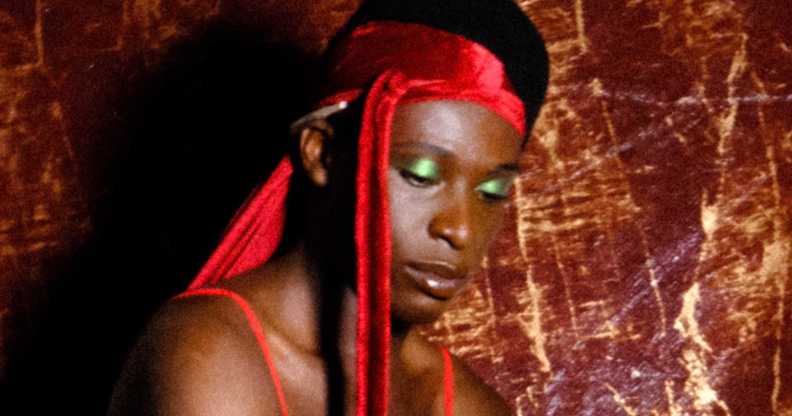Fringe of Colour festival counters ‘white, heteronormative’ Edinburgh Fringe with queer artists of colour

Soft Bwoi. (Danny Bailey/Fringe Of Colour Films)
Fringe of Colour began life as a spreadsheet listing shows by artists of colour at the Edinburgh Fringe in 2018. Now, it’s a thriving arts festival that celebrates queer resilience, sex and cunning.
The Fringe of Colour Films festival, which runs until 29 June, is a treasure trove of moving images, panel discussions, poetry performances and more, featuring work by queer people of colour from across the world.
While you can still access the original database, which is updated annually, the project has grown into an award-winning initiative with online and in-person screenings, that has evolved away from “conversations of representation”.
Director and founder Jess Brough says: “The festival is less about ‘look at us like we exist, we’re here,’ and more, ‘Can we exist outside of this very, very white heteronormative structure and do our own thing?’”
It’s a sentiment echoed in the festival slogan: “A hybrid arts festival for us, by us.”
Importantly, the “us” includes not just people of colour, but queer people of colour. It’s something you might miss if you don’t have a discerning eye… or gaydar.
Brough explains the reasoning behind the subtle rather than overt queerness of the festival, saying: “Because we work with writers who are from all around the world and in places where it’s not safe to be out as queer, I had to make a decision about whether this was going to be an explicitly queer festival.”
It’s a path that queer people have travelled before: being hidden in plain sight – visible to other LGBTQ+ people, but less obvious to homophobes, transphobes and others who wish us harm.
“People who submit work to the festival and do a bit of research can look at our team page and see how many people are ostensibly queer, through their pronouns or just in general,” Jess adds.
While scrolling the team page, you’ll find the queer aesthetics on display: nose piercings, gold-rimmed librarian glasses, micro-fringes. It’s enough for anyone with any queer sensibilities to understand that this is not just a queer-friendly initiative, but one with LGBTQ+ experiences and perspectives front and centre. In Jess’ own words: “The queerness is there if you’re looking for it.”
This playful, tricksy approach that offers a platform while obscuring queerness for safety reasons, makes me think of Still We Thrive, a short film by Campbell X being shown in the Fringe of Colour festival this year. The poetic, narration-led piece celebrates queer Black resilience and stars Trinidadian-British actor Don Warrington. “We are descendants from the trickster god, Anansi. And so with each generation, we outsmart our colonisers,” says Warrington, who is probably best known for playing Selwyn Patterson in Death in Paradise.
I think also of Bateria, a film about gay cruising in Havana, which is also being screened. It’s a haunting, atmospheric piece that moves through a disused military base now transformed into a sanctuary for gay sex and intimacy. “At home, I try not to gesticulate too much,” says the narrator of his closeted home life, but with friends, he finds himself “more relaxed and bootylicious”.
Both the Fringe of Colour project, and the films it gives a platform to, speak to the ways in which queer people of colour must navigate safe and unsafe spaces and communities with cunning and camouflage. The experiences of closeted queer people are also central to Fringe of Colour’s focus on film.
“The thing with film that I find really empowering, as opposed to live theatre, is that people can generally access it from anywhere,” says Brough. “You might be the only queer person in your village, but you can watch this film and realise you’re not alone in the experiences you are going through.
“All of the queer films I watched as a teenager, secretly in my bedroom, are still so meaningful to me because they showed me that actually, the not-normal was the thing that I should be looking forward to.”
For Brough, this “not normal” is the way in which queer romance resists the shapes and standards of heterosexual relationships. But it can also be about rejecting societal norms more broadly.
(Tending) (to) (Ta), by non-binary writer April Lin, explores resisting the dreariness of capitalism. Their hypnotic, reverie-like tale takes place across two parallel dimensions: a utopian world of leisure, ritual and connection to nature, and the more familiar one of enduring a 9-to-5 life in London. The brutality and confines of urban architecture are contrasted with the expansive, time-slowing qualities of nature, as protagonists from the different worlds connect across the cosmos. I loved it, but admittedly I am a bit of a woo-woo gay.
Soft Bwoi is another entry in this year’s programme that celebrates the “not normal”. In this electric, rhythmic nod to Jamaican sound-system culture, queer – or “soft” – masculinities are unapologetically reclaimed. “Real bad man nuh afraid of him softness” says the film’s writer, director and narrator, Danny Bailey. Speaking directly to the suffocating expectations around Black men’s gender performance, the film closes with the words: “Open your eyes, there’s work to do.”
And there is indeed, work to do. The Fringe of Colour festival experienced a flurry of media interest in 2020 following global reflection and conversations on anti-Black racism (sparked by the death of George Floyd).
Brough tells me that in 2020, alongside a lot of people buying passes and donating to the festival out of “white guilt”, they were also invited to speak on the radio and interviewed by the BBC. However, once the Black Lives Matter “moment” – to use the words of Keir Starmer – had passed, so too had the media interest in work by queer artists of colour.
“I remember in 2021 being like, ‘let me reach out to these same people who were interested in us in 2020’, and it was very notably quiet,” Brough recalls. “Racial awareness or radical displays of solidarity or whatever it was, was such a transient thing. It just did not continue.”
Getting people to care – and keep caring – about art that isn’t white or straight, has its challenges, but Brough and their team aren’t defeated. “I have hope that just by being here, being present and doing the best we can, the audiences we have will keep coming back.”
How did this story make you feel?

